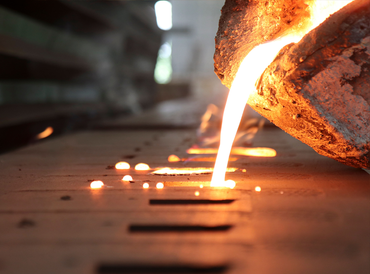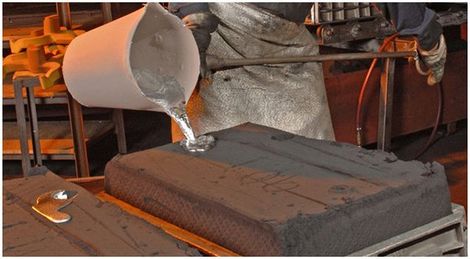Career Paths in the Metal Casting Industry and How to Get Started
Wiki Article
Exploring the Art of Metal Casting: Strategies and Applications in Modern Foundries
Metal casting is a classic craft that integrates artistry with engineering precision. From ancient strategies to contemporary improvements, this procedure has evolved significantly. Numerous techniques, such as sand casting and lost-wax casting, display the versatility of the tool. Advancements like 3D printing are improving exactly how factories operate. As the lines between performance and virtuosity blur, one should take into consideration exactly how these growths impact both modern applications and traditional techniques. What exists in advance in this advancing landscape?The Principles of Metal Casting
Metal casting, an essential procedure in manufacturing, involves putting liquified metal right into a mold to attain a desired shape. This strategy works as a foundation in the manufacturing of complicated steel elements throughout various industries. Secret components of metal casting include the choice of products, which can range from light weight aluminum to steel, each selected for its particular homes and application suitability. The process starts with mold development, which can be made from sand, steel, or ceramics, depending upon the casting approach used. The liquified metal is then very carefully put right into the mold and mildew, where it cools down and solidifies. Important factors such as temperature level control, cooling price, and mold style greatly affect the end product's high quality and characteristics. Furthermore, comprehending the chemical and physical homes of the metal aids in maximizing casting efficiency, eventually boosting the effectiveness of the production procedure and ensuring top quality outcome tailored to specific requirements.Standard Casting Strategies
Standard casting techniques encompass a range of approaches that have actually stood the test of time, demonstrating their efficiency in generating complex metal elements. One famous approach is sand casting, which employs a combination of sand and a bonding representative to create mold and mildews. The flexibility of sand casting enables the manufacturing of diverse forms, making it ideal for both massive and small-scale production. One more notable technique is financial investment casting, often used for complicated and specific geometries. This technique entails producing a wax pattern that is covered in a ceramic shell, which is after that warmed to eliminate the wax, leaving a tooth cavity for molten metal. Furthermore, pass away casting is made use of for high-volume manufacturing, where liquified steel is injected into recyclable metal molds. Each of these standard methods remains appropriate, showcasing the workmanship and ability inherent in the art of steel casting, while meeting the needs of different sectors.Modern Innovations in Metal Casting
As markets develop, innovations in steel casting are reshaping manufacturing processes and boosting efficiency. Advanced modern technologies such as 3D printing and computer-aided layout (CAD) are revolutionizing mold development, permitting detailed designs that were formerly unattainable. These techniques facilitate quick prototyping, fostering and lowering lead times imagination in product advancement.In addition, the combination of automation and robotics in foundries is simplifying procedures, minimizing human mistake, and raising security. Smart sensing units and real-time surveillance systems make it possible for accurate control you could try these out of temperature level and product properties, making sure better results.
Additionally, sustainable methods are emerging, with making use of energy-efficient heaters and recycled products, lowering environmental effect. The fostering of composite materials and sophisticated alloys is additionally expanding the opportunities of steel casting, resulting in more powerful and lighter components. Overall, these modern technologies are transforming steel casting into a much more efficient, accurate, and environmentally responsible industry.
Applications Throughout Numerous Industries

While diverse markets progressively rely upon steel casting, the method's adaptability plays an important function in meeting specific application needs. In the auto field, metal casting is vital for generating engine components, transmission housings, and various other detailed components that require precision and resilience. The aerospace sector gain from light-weight casted elements, ensuring both performance and gas performance. Furthermore, the building sector makes use of metal casting for architectural components, such as beam of lights and supports, improving the honesty of buildings and bridges.
The energy field utilizes steel casting for turbine blades and other substantial machinery that have to endure extreme problems. Medical devices also see applications of metal casting, especially in medical instruments and prosthetics, where precision is crucial - Aluminum Foundry. On the whole, the flexibility and integrity of steel casting make it crucial across various fields, adding to the advancement of modern technology and infrastructure in contemporary society
The Artistic Side of Metal Casting
Although usually connected with industrial applications, steel casting additionally locates its area in the domain name of art, where experienced artisans transform liquified steel into expressive sculptures and detailed designs. This artistic side of steel casting incorporates diverse techniques, consisting of sand best site casting, lost-wax casting, and financial investment casting, each offering special opportunities for imagination. Musicians utilize these methods to create works that range from abstract kinds to realistic depictions, enabling individual expression and discourse on modern problems.
Regularly Asked Concerns
What Safety Steps Are Essential in a Metal Casting Foundry?
Vital security measures in a steel casting shop include personal protective tools, appropriate air flow, emergency protocols, training in managing molten steels, routine equipment maintenance, and clear communication of hazards to ensure employee security and health. Metal Casting.How Do Ecological Regulations Influence Metal Casting Processes?
Ecological laws significantly affect metal casting procedures by mandating making use of cleaner technologies, minimizing discharges, and promoting waste monitoring techniques. Compliance often requires financial investments in equipment, training, and alterations to existing procedures to reduce ecological effect.What Are the Typical Issues in Metal Spreadings?
Typical problems in metal spreadings consist of porosity, contraction, incorporations, and misruns. These problems can develop from inappropriate mold and mildew layout, poor temperature level control, or contamination, inevitably influencing the structural stability and total quality of the last product.Just How Is Waste Managed During Metal Casting Manufacturing?
Waste monitoring in steel casting production includes recycling scrap metal, carrying out efficient material use, and making use of innovative innovations to lessen waste. Foundries adopt practices like sand reclamation and appropriate disposal approaches to lower environmental influence.What Occupation Opportunities Exist in the Metal Casting Sector?
The steel casting industry supplies varied occupation opportunities, including roles such as factory supervisor, metallurgical engineer, quality assurance examiner, pattern manufacturer, and production manager, catering to different ability and experience in manufacturing processes.Metal find here casting, a crucial process in production, entails putting liquified metal right into a mold to achieve a preferred shape. In addition, pass away casting is made use of for high-volume production, where molten metal is infused into recyclable steel molds. While varied industries increasingly depend on metal casting, the method's adaptability plays an important function in conference certain application demands. Typically connected with industrial applications, steel casting also discovers its area in the domain name of art, where experienced artisans change liquified steel into elaborate layouts and expressive sculptures. Waste monitoring in metal casting manufacturing involves recycling scrap metal, carrying out efficient product usage, and utilizing advanced innovations to lessen waste.
Report this wiki page